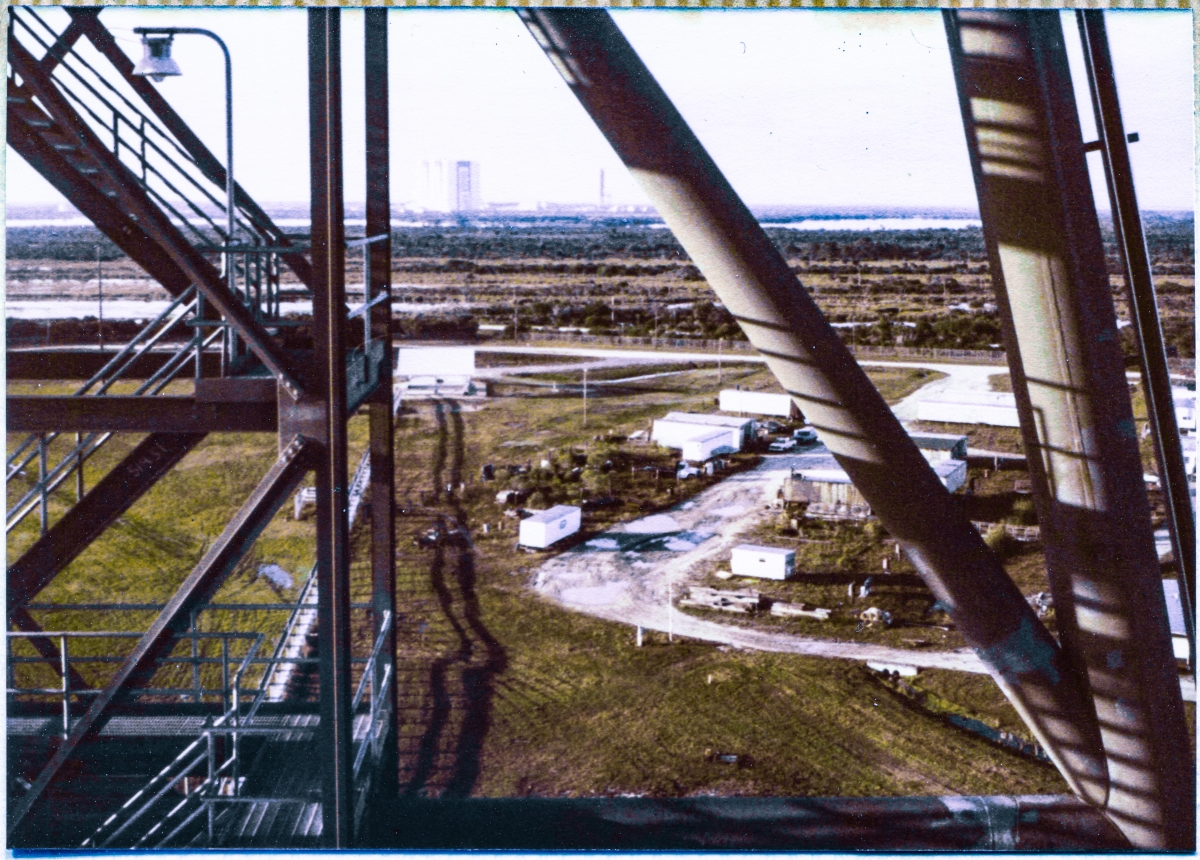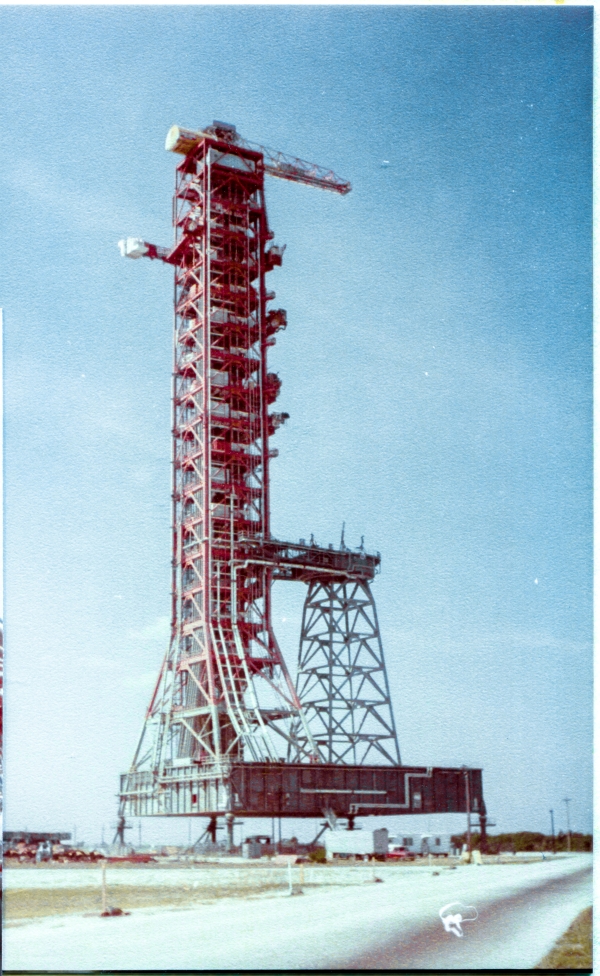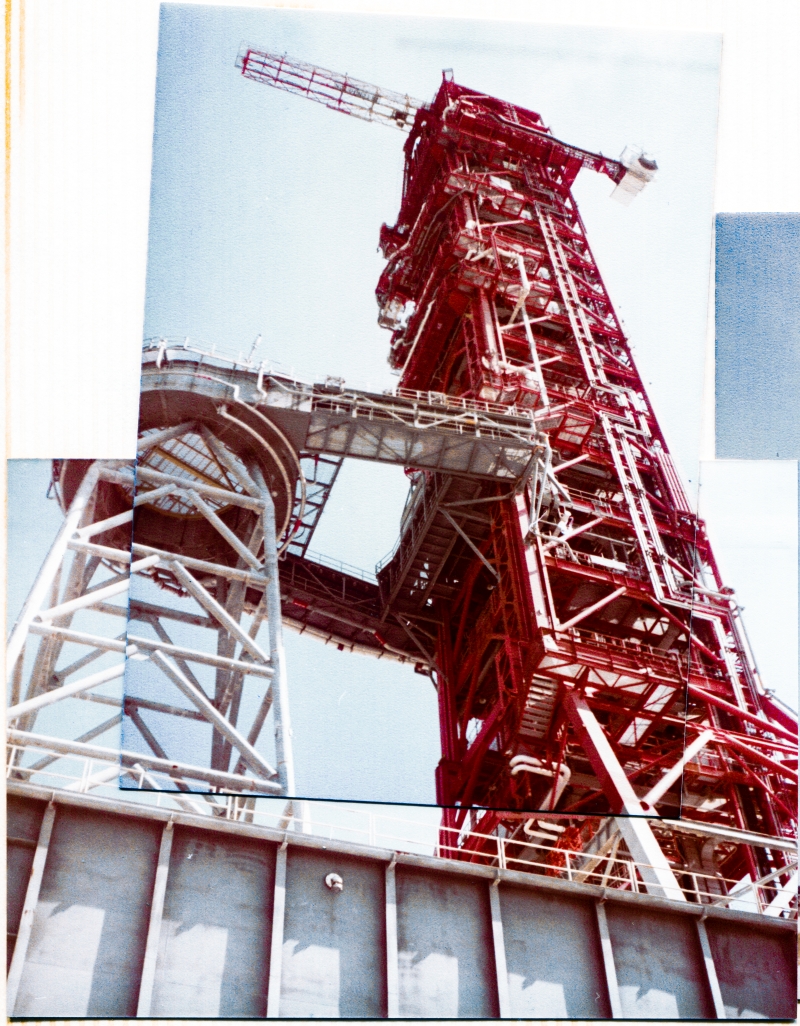The Construction of Space Shuttle Launch Complex 39-B
A very personal and technical written and photographic history, by James MacLaren.
Page 26: VAB and LUT Viewed Through Column Line 7.
| Pad B Stories - Table of Contents |

Just another one of those views.
The hulking mass of the VAB was always there whether visible in the distance, or not.
It is itself, and it is also, at the very same time, something other.
We read what we will, into that which we see, and there are certain things that bring this aspect out in certain people to a larger degree than usual, and the VAB is one of those things.
I am not one to believe in spirits, afterlives, gods, or devils, and yet...
The air seemed to hold something in the vicinity of that colossal box, squatting enigmatically on the horizon, ever-present, ever-mysterious.
And that, even though I knew full-well exactly how it was constructed, and exactly what it contained, and exactly what went on in there daily, and had visited it more than enough times to develop a workman's familiarity with it, and was under no illusions that anything special might have been going on with it.
And yet... The shadows cast by Apollo were very long, and they were also, in a certain peculiar way, very dark.
The gods themselves would have been astounded with the work that came, was, and went, in and around that box.
The builders of Stonehenge or perhaps the Pyramids would have understood the feeling exactly.
And so it is early morning, and you find yourself down on the very lowest level of the RSS with some free time to loiter, to consider, to perhaps let the air fill your sails and propel you, if only for a few moments.
And the VAB sits there on top of the far horizon, bathed in the hazes of distance that wrap far things, Sphinx-like, inaudibly speaking to you.
And one day the sea will rise and take it, take the very ground it rests upon, and it will be gone, and the shadows will only get darker.
But for now, let us leave the considerations of Things Writ Large behind, and see if we can locate ourselves on the iron.
And the very distinctive look of the Primary Framing of Column Line 7 should immediately tell is that we are looking out from somewhere back on the main body of the RSS toward Line 7 and a bit of what can only be Stair Tower 3, intertwined with it.
We are not quite looking exactly in the opposite direction from the place which the photograph on the previous page was taken, and we're not exactly at the same elevation that photograph was taken from, but we're close.
We're very close.
Up a little in elevation, and across the depth of the RSS toward Column Line A a little.
We are standing here, over one hundred feet above the surrounding landscape, and our previous location on Stair Tower 3 was one Landing Level below, and just out of frame to the left, in this view.
In the distance, the features of the VAB are easily-recognizable, but the Launch Umbilical Tower (On top of Mobile Launcher 1, which Apollo 11 launched from and which was the last remaining LUT from the Apollo Program that was still intact when this photograph was taken, the other two already having been converted into the Fixed Service Structures on Pad A and Pad B.) sitting north of the VAB at the Mobile Launcher Park Site, is less so, and it takes a bit of a look to see and recognize the "Milk Stool" which was added to enable Saturn 1B launches, the very last of which was the Apollo-Soyuz Test Project, flown from Pad B, which of course is where you are looking at it from in the photograph at the top of this page.
And maybe one day Dick Walls tells you to head on over to the the Park Site and pick up a five gallon bucket the zinc dust which makes up most of the "inorganic zinc primer" which everything out here is painted in, and which Wilhoit needs right away for some reason, and so you get in your rusted VW, and go. And on your way, shortly after you've taken the turn that leads you around to the north side of the VAB, you pull over to the side of the road, get out, and take a picture of the gigantic doomed piece of World History that's sitting out there directly in front of you.
The last solid object on the surface of the Earth which the very first people to ever visit the Moon were physically in contact with, before riding their volcano into the sky.

And then you get back in your car and drive around over on the far side of things where your five-gallon metal can of zinc dust is waiting for you, and you go to pick it up to put it in the car, not knowing anything at all about this stuff, and holy shit, this crap is heavy, and you can hardly lift it off the ground, and you fear greatly the handle breaking and the can landing on your foot, fracturing every bone that winds up underneath it, and you fear it going through the floorboards of the car, but somehow you manage to get it in there, and you're good for departure back to the Pad, but before you go, you pull out the camera once again, and take a few frames hoping you might be able to overlap them, and try, futilely, but try anyway, to convey the sense of this tremendous thing looming into the sky above you, but you know, even as you are hitting the shutter release, that there's no way. There's no way in hell that you stand the least imaginable chance of capturing this thing, but you take the pictures anyway, and console yourself that to some microscopic degree, it's better than nothing at all.

Strictly speaking, the "Mobile Launcher" comprised all of the elements, box and tower, with the "Launch Umbilical Tower" being only the tower, and nothing else, but in common usage out on the pad, nobody ever referred to it as "Mobile Launcher 1", or simply "the Mobile Launcher", and instead it was invariably referred to as the "LUT", which was pronounced as a word, "lut" with a short 'u' sound, and never as an acronym. So you're looking at the last surviving LUT, sitting at the Park Site over there by the VAB, in these photographs.
In our photograph at the top of this page, almost, but not quite, obscured by the framing steel of Stair Tower 3, you can see the Hypergolic Fuel Storage Facility which is isolated away from everything else most of the way out to the Pad Perimeter Road. The oxidizer facility was all the way over on the other side of the Pad, similarly located. That these small buildings were as far removed from everything else as they were, while still managing to stay within the Pad Perimeter, should be all you might ever want to know about hypergol, although by now you've learned plenty more than that.
Mostly-obscured by Stair 3's framing steel, the cross-country piping line which took the MMH from the its Storage Facility to the Pad can be seen, too. That the entire run of piping, plus associated electrical conduits and grounding, as well as Firex lines and all other ancillary instrumentation and systems, stands sensibly above the landscape it crosses, can be very easily determined via the long pair of shadows to its right, cast against the open ground beneath it by the exceedingly low-angle morning sunlight.
And to the right of that, you can see the muddy potholed dirt road that ran around through the tool and equipment trailers, which were located behind the main administrative Contractor Field Trailers area (which is where my desk in the Sheffield Steel trailer was located), the merest sliver of which can be seen behind the Cable Tray which ran along the Line A side of Column Line 7 and which routed power and instrumentation feeds down to the RSS Truck Drives.
And, all in all, from the literal Moon Rocket Assembly Building and Launch Platform in the distance, down to the muddy water on that dirt road with the ratty-looking trailers and junk on either side of it, we're looking at a very significant distance from high to low in this particular image.
Quite the contrast.
Return to 16streets.comACRONYMS LOOK-UP PAGEContact Email Link |